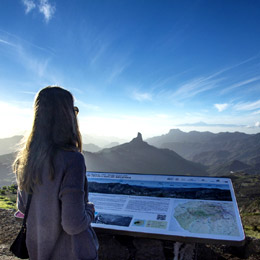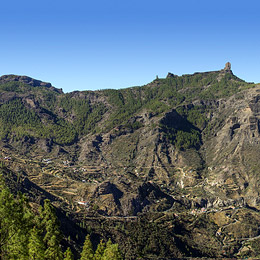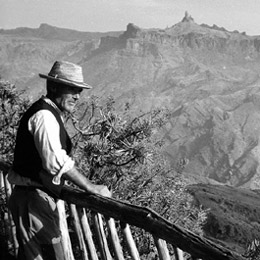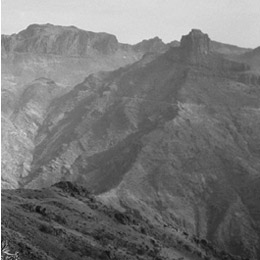This gorge is the dividing line between the municipalities of Vega de San Mateo and Tejeda, and is defined by the Montañas de la Almagria, to the north, and Las Mejoranas, to the south, and is without doubt the most reknowned skyline in the whole of Gran Canaria.


Opposite, sticking out in a line against the sky, as if posing unexpectedly on high especially for visitors, are the rocks bearing witness to the ancient volcano that was once the centre of the island… Revealed is a Friar-shaped rock which is keeping a close eye on the Roque Nublo, with a rocky frog sitting alongside. On the edge of this platform a woman’s face is looking up to the sky. Her hair falls into the abyss of the Risco de la Foguera. Further on, standing out from the heart of the erosive Tejeda crater is the Roque Bentayga, a sacred spot for the original inhabitants of the island, as the archaeological settlements nearby bear witness.
Hundreds of thousands of years of erosion have dragged the materials along the ravines that are etched into the slope, shaping its terrain. Smaller ravines join together to make up the Barranco Grande that peters out into the Playa del Charco: The ravines at Tumba, Tejeda, El Juncal, El Chorrillo, Siberio, all of these come down from great heights in search of fertile valleys beyond El Morro del Ámbar in La Aldea de San Nicolás.


The settlements of Tejeda, Artenara, La Culata, El Roque and Juan Fernández, leave their white marks on this magma sea of materials, colours, shapes and textures, together with the pine tree vegetation dotted about and running into the basin, and the scotch broom darkened by the humble codeso and given a silver tinge by tree lucernes.
Special mention must go to the quote made by D. Miguel de Unamuno en La Gran Canaria, for its visual interpretation. “It is like a tremendous commotion from the guts of the earth, it looks just like a fossilised storm, but also a storm more of fire and lava, than of water.”
This whole area forms part of the World Reserve of the Gran Canaria Biosphere, as declared by UNESCO on 29th June 2005.
